
Hygrocybe is a genus of agarics in the family Hygrophoraceae. Called waxcaps in English, basidiocarps are often brightly coloured and have dry to waxy caps, white spores, and smooth, ringless stems. In Europe they are characteristic of old, unimproved grasslands which are a declining habitat, making many Hygrocybe species of conservation concern. Four of these waxcap-grassland species, Hygrocybe citrinovirens, H. punicea, H. spadicea, and H. splendidissima, are assessed as globally "vulnerable" on the IUCN Red List of Threatened Species. Elsewhere waxcaps are more typically found in woodlands. Most are ground-dwelling and all are believed to be biotrophs. Around 150 species are recognized worldwide. Fruit bodies of several Hygrocybe species are considered edible and are sometimes offered for sale in local markets.
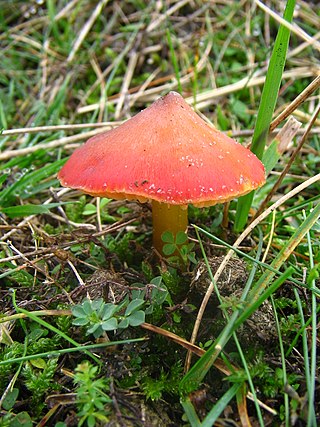
Hygrocybe conica is a species of agaric in the family Hygrophoraceae. In the UK it has been given the recommended English name of blackening waxcap, since all parts of the basidiocarp blacken with age. In North America it is commonly known as the witch's hat, conical wax cap or conical slimy cap. Hygrocybe conica is known to be a complex of at least eleven closely related species and as such is widespread in Europe, North America, Asia, and elsewhere.

Hygrocybe punicea is a species of agaric in the family Hygrophoraceae. It has been given the recommended English name of crimson waxcap. The species has a European distribution, occurring mainly in agriculturally unimproved grassland. Threats to its habitat have resulted in the species being assessed as globally "vulnerable" on the IUCN Red List of Threatened Species. Records of H. punicea from North America, East Asia, and Australia require further research to see if they represent the same species.

Cuphophyllus is a genus of agaric fungi in the family Hygrophoraceae. Cuphophyllus species belong to a group known as waxcaps in English, sometimes also waxy caps in North America or waxgills in New Zealand. In Europe, Cuphophyllus species are typical of waxcap grasslands, a declining habitat due to changing agricultural practices. As a result, four species, Cuphophyllus atlanticus, C. colemannianus, C. lacmus, and C. lepidopus are of global conservation concern and are listed as "vulnerable" on the IUCN Red List of Threatened Species.

Gliophorus is a genus of agaric fungi in the family Hygrophoraceae. Gliophorus species belong to a group known as waxcaps in English, sometimes also waxy caps in North America or waxgills in New Zealand. In Europe, Gliophorus species are typical of waxcap grasslands, a declining habitat due to changing agricultural practices. As a result, two species, Gliophorus europerplexus and Gliophorus reginae, are of global conservation concern and are listed as "vulnerable" on the IUCN Red List of Threatened Species.
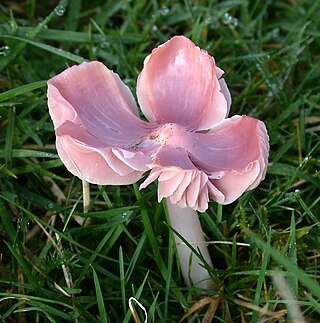
Porpolomopsis calyptriformis, commonly known as the pink wax cap, ballerina waxcap or salmon waxy cap, is a species of agaric in the family Hygrophoraceae. The species has a European distribution, occurring mainly in agriculturally unimproved grassland. Threats to its habitat have resulted in the species being assessed as globally "vulnerable" on the IUCN Red List of Threatened Species. A similar but as yet unnamed species occurs in North America.

Cuphophyllus pratensis is a species of agaric in the family Hygrophoraceae. It has been given the recommended English name of meadow waxcap in the UK and in North America has variously been called the meadow waxy cap, salmon waxy cap, and butter meadowcap. The species has a widespread, mainly temperate distribution, occurring in grassland in Europe and in woodland elsewhere. The basidiocarps are edible and are occasionally collected and sold commercially.

Gliophorus irrigatus is a species of agaric in the family Hygrophoraceae. It has been given the recommended English name of slimy waxcap in the UK. The species is widespread in temperate regions, occurring in grassland in Europe and in woodland in North America and elsewhere.

Gliophorus europerplexus is a species of agaric in the family Hygrophoraceae. It has been given the recommended English name of butterscotch waxcap. The species has a European distribution, occurring mainly in agriculturally unimproved grassland. Threats to its habitat have resulted in the species being assessed as globally "vulnerable" on the IUCN Red List of Threatened Species.

Gliophorus reginae is a species of agaric in the family Hygrophoraceae. It has been given the recommended English name of jubilee waxcap. The species has a European distribution, occurring mainly in agriculturally unimproved grassland. Threats to its habitat have resulted in the species being assessed as globally "vulnerable" on the IUCN Red List of Threatened Species.
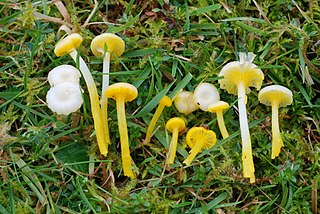
Gloioxanthomyces vitellinus is a species of agaric in the family Hygrophoraceae. It has been given the recommended English name of Glistening Waxcap. The species has a European distribution, occurring mainly in agriculturally unimproved grassland. Threats to its habitat have resulted in the Glistening Waxcap being assessed as globally "endangered" on the IUCN Red List of Threatened Species.

Hygrocybe splendidissima, is a species of agaric in the family Hygrophoraceae. It has been given the recommended English name of Splendid Waxcap. The species has a European distribution, occurring mainly in agriculturally unimproved grassland. Threats to its habitat have resulted in the species being assessed as globally "vulnerable" on the IUCN Red List of Threatened Species.

Neohygrocybe ingrata is a species of agaric in the family Hygrophoraceae. It has been given the recommended English name of dingy waxcap. The species has a European distribution, occurring mainly in agriculturally unimproved grassland. Threats to its habitat have resulted in the species being assessed as globally "vulnerable" on the IUCN Red List of Threatened Species.

Hygrocybe citrinovirens is a species of agaric in the family Hygrophoraceae. It has been given the recommended English name of Citrine Waxcap. The species has a European distribution, occurring mainly in agriculturally unimproved grassland. Threats to its habitat have resulted in the species being assessed as globally "vulnerable" on the IUCN Red List of Threatened Species.

Neohygrocybe ovina is a species of agaric in the family Hygrophoraceae. It has been given the recommended English name of blushing waxcap, since the lamellae (gills) and flesh turn pinkish red when bruised. The species has a European distribution, occurring mainly in agriculturally unimproved grassland. Threats to its habitat have resulted in the species being assessed as globally "vulnerable" on the IUCN Red List of Threatened Species.
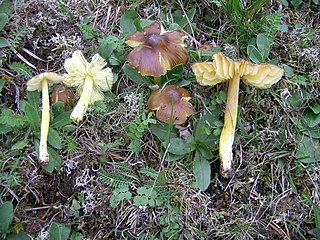
Hygrocybe spadicea is a species of agaric in the family Hygrophoraceae. It has been given the recommended English name of Date Waxcap. The species has a European distribution, occurring mainly in agriculturally unimproved grassland. Threats to its habitat have resulted in the species being assessed as globally "vulnerable" on the IUCN Red List of Threatened Species.
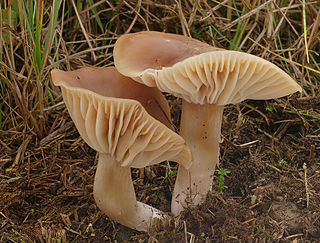
Cuphophyllus colemannianus is a species of agaric in the family Hygrophoraceae. It has been given the recommended English name of toasted waxcap. The species has a European distribution, occurring mainly in agriculturally unimproved grassland. Threats to its habitat have resulted in the species being assessed as globally "vulnerable" on the IUCN Red List of Threatened Species.

Cuphophyllus lacmus is a species of agaric in the family Hygrophoraceae. It has been given the recommended English name of grey waxcap. The species has a European distribution, occurring mainly in agriculturally unimproved grassland. Threats to its habitat have resulted in the species being assessed as globally "vulnerable" on the IUCN Red List of Threatened Species.
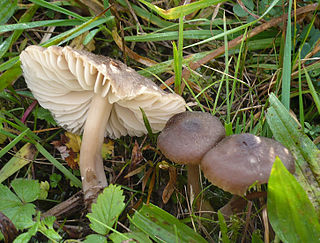
Neohygrocybe nitrata is a species of agaric in the family Hygrophoraceae. It has been given the recommended English name of nitrous waxcap, based on its smell. The species has a European distribution, occurring mainly in agriculturally unimproved grassland. Threats to its habitat have resulted in the species being assessed as globally "vulnerable" on the IUCN Red List of Threatened Species.
Cuphophyllus lepidopus is a species of agaric in the family Hygrophoraceae. It has been given the recommended English name of scalyfoot waxcap. The species has a European distribution, occurring mainly in agriculturally unimproved grassland. Threats to its habitat have resulted in the species being assessed as globally "vulnerable" on the IUCN Red List of Threatened Species.


















